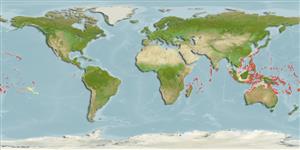Classification / Names
Common names from other countries
Main reference
Size / Weight / Age
Max length : 13.0 cm TL male/unsexed; (Ref. 30874)
Environment
Marine; reef-associated; depth range 1 - 25 m (Ref. 9710)
Climate / Range
Tropical, preferred ?; 31°N - 23°S
Distribution
Indo-West Pacific: Mauritius, Christmas Island, southern Japan, Marcus Islands, southern Taiwan, Australia, New Caledonia, Marshall Islands, Johnston Island, and Hawaiian Islands; distribution anti-equatorial. Recently reported from Tonga (Ref. 53797). Replaced by Pervagor marginalis in the Line and Marquesas Islands (Ref. 37816).
Countries | FAO areas | Ecosystems | Occurrences | Introductions
Short description
Dorsal
spines
(total): 1 - 2;
Dorsal
soft rays
(total): 31-35;
Anal
spines: 0;
Anal
soft rays: 28 - 32. First dorsal spine strong. Posterior margin of ventral flap narrowly attached to large pelvic fin rudiment. Scale spinulation in midbody not closely packed. Body and head color variable; orange to brown iris; caudal fin yellow or orange; soft dorsal and anal fins clear to yellowish; spinous dorsal dark brown to brownish orange; pectorals clear. Numerous spots in head and body appear as dashes or lines Male scale ridge rugosities usually develop at about 60 mm SL.
IUCN Red List Status (Ref. 115185)
Threat to humans
Harmless
Human uses
More information
Common namesSynonymsMetabolismPredatorsEcotoxicologyReproductionMaturitySpawningFecundityEggsEgg development
ReferencesAquacultureAquaculture profileStrainsGeneticsAllele frequenciesHeritabilityDiseasesProcessingMass conversion
Tools
Special reports
Download XML
Internet sources
Estimates of some properties based on models
Phylogenetic diversity index
PD50 = 0.5039 many relatives (e.g. carps) 0.5 - 2.0 few relatives (e.g. lungfishes)
Trophic Level
2.9 ±0.4 se; Based on size and trophs of closest relatives
Resilience
High, minimum population doubling time less than 15 months (Preliminary K or Fecundity.)
Vulnerability
Low vulnerability (21 of 100)
Price category
